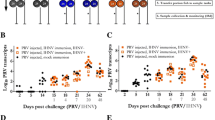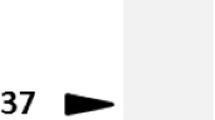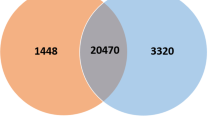Abstract
Infectious hematopoietic necrosis virus (IHNV) causes clinical diseases and mortality in a wide variety of salmonid species. Here, we studied transcriptional responses in rainbow trout infected by the IHNV-Nagano strain isolated in Korea. RNA-seq-based transcriptome analysis of head kidney tissues cataloged differentially expressed genes. Enrichment analysis of gene ontology annotations was performed, and a total of fifteen biological process terms were commonly identified at all time points. In the Kyoto Encyclopedia of Genes and Genomes pathway analysis, pathogen recognition receptor (PRR) signaling pathways such as the retinoic-acid-inducible gene-I-like receptor signaling pathway and the Toll-like receptor signaling pathway were identified at all time points. The nucleotide-binding oligomerization-domain-like receptor signaling pathway and cytosolic DNA-sensing pathway were identified at days 1 and 3. Protein-protein interaction network and centrality analyses revealed that the immune system, signaling molecules, and interaction pathways were upregulated at days 1 and 3, with the highest centrality of tumor necrosis factor. Cancer, cellular community, and endocrine system pathways were downregulated, with the highest centrality of fibronectin 1 at day 5. STAT1 was upregulated from days 1 to 5 with a high centrality. The reproducibility and repeatability of the transcriptome analysis were validated by RT-qPCR. IHNV-Nagano infection dynamically changed the transcriptome profiles in the head kidney of rainbow trout and induced a defense mechanism by regulating the immune and inflammatory pathways through PRR signaling at an early stage. Downregulated pathways involved in extracellular matrix formation and focal adhesion at day 5 indicated the possible failure of wound healing, which is important in the pathogenesis of IHNV infection.




Similar content being viewed by others
References
Park MA, Sohn SG, Lee SD, Chun SK, Park JW, Fryer JL, Hah YC (1993) Infectious haematopoietic necrosis virus from salmonids cultured in Korea. J Fish Dis 16(5):471–478
Dixon P, Paley R, Alegria-Moran R, Oidtmann B (2016) Epidemiological characteristics of infectious hematopoietic necrosis virus (IHNV): a review. Vet res 47(1):63
Kurath G, Leong JC (1985) Characterization of infectious hematopoietic necrosis virus mRNA species reveals a nonvirion rhabdovirus protein. J virol 53(2):462–468
Morzunov SP, Winton JR, Nichol ST (1995) The complete genome structure and phylogenetic relationship of infectious hematopoietic necrosis virus. Vir res 38(2–3):175–192
Fauquet CM, Mayo MA, Maniloff J, Desselberger U, Ball LA (2005) Virus taxonomy: VIIIth report of the International Committee on Taxonomy of Viruses. Academic Press
Mochizuki M, Kim HJ, Kasai H, Nishizawa T, Yoshimizu M (2009) Virulence change of infectious hematopoietic necrosis virus against rainbow trout Oncorhynchus mykiss with viral molecular evolution. Fish Pathol 44(4):159–165
Nishizawa T, Kinoshita S, Kim WS, Higashi S, Yoshimizu M (2006) Nucleotide diversity of Japanese isolates of infectious hematopoietic necrosis virus (IHNV) based on the glycoprotein gene. Dis Aqua Org 71(3):267–272
Purcell MK, Laing KJ, Winton JR (2012) Immunity to fish rhabdoviruses. Viruses 4(1):140–166
Purcell MK, Kurath G, Garver KA, Herwig RP, Winton JR (2004) Quantitative expression profiling of immune response genes in rainbow trout following infectious haematopoietic necrosis virus (IHNV) infection or DNA vaccination. Fish Shellfish Immunol 17(5):447–462
Saint-Jean SR, Pérez-Prieto SI (2006) Interferon mediated antiviral activity against salmonid fish viruses in BF-2 and other cell lines. Vet Immunol Immunopathol 110(1–2):1–10
Wang ZX, Zhou Y, Lu LF, Lu XB, Ni B, LuOuyang MXS (2020) Infectious hematopoietic necrosis virus N protein suppresses fish IFN1 production by targeting the MITA. Fish Shellfish Immunol 97:523–530
Chiou PP, Kim CH, Ormonde P, Leong JAC (2000) Infectious hematopoietic necrosis virus matrix protein inhibits host-directed gene expression and induces morphological changes of apoptosis in cell cultures. J Virol 74(16):7619–7627
Kim WS, Oh MJ, Nishizawa T, Park JW, Kurath G, Yoshimizu M (2007) Genotyping of Korean isolates of infectious hematopoietic necrosis virus (IHNV) based on the glycoprotein gene. Arch Virol 152(11):2119–2124
Katze MG, He Y, Gale M (2002) Viruses and interferon: a fight for supremacy. Nat Rev Immunol 2(9):675–687
Takaoka A, Hayakawa S, Yanai H, Stoiber D, Negishi H, Kikuchi H, Taniguchi T (2003) Integration of interferon-α/β signalling to p53 responses in tumour suppression and antiviral defense. Nature 424(6948):516–523
Sudhagar A, Kumar G, El-Matbouli M (2018) Transcriptome analysis based on RNA-seq in understanding pathogenic mechanisms of diseases and the immune system of fish: a comprehensive review. Int J Mol Sci 19(1):245
Polinski MP, Bradshaw JC, Rise ML, Johnson SC, Garver KA (2019) Sockeye salmon demonstrate robust yet distinct transcriptomic kidney responses to rhabdovirus (IHNV) exposure and infection. Fish Shellf Immunol 94:525–538
Müller A, Sutherland BJ, Koop BF, Johnson SC, Garver KA (2015) Infectious hematopoietic necrosis virus (IHNV) persistence in Sockeye Salmon: influence on brain transcriptome and subsequent response to the viral mimic poly (I: C). BMC Genom 16(1):634
Kim KI, Cha SJ, Lee C, Baek H, Hwang SD, ChoMY PMA (2016) Genetic relatedness of infectious hematopoietic necrosis virus (IHNV) from cultured salmonids in Korea. Arc Virol 161(8):2305–2310
Andrews S (2010) FastQC: a quality control tool for high throughput sequence data.
Zhou Q, Su X, Jing G, Chen S, Ning K (2018) RNA-QC-chain: comprehensive and fast quality control for RNA-Seq data. BMC Genom 19(1):144
Trapnell C, Pachter L, Salzberg SL (2009) TopHat: discovering splice junctions with RNA-Seq. Bioinformatics 25(9):1105–1111
Trapnell C, Williams BA, Pertea G, Mortazavi A, Kwan G, Van Baren MJ, Pachter L (2010) Transcript assembly and quantification by RNA-Seq reveals unannotated transcripts and isoform switching during cell differentiation. Nat Biotechnol 28(5):511
Jones P, Binns D, Chang HY, Fraser M, Li W, McAnulla C, Pesseat S (2014) InterProScan 5: genome-scale protein function classification. Bioinformatics 30(9):1236–1240
Trapnell C, Roberts A, Goff L, Pertea G, Kim D, Kelley DR, Pachter L (2012) Differential gene and transcript expression analysis of RNA-seq experiments with TopHat and Cufflinks. Nat Proto 7(3):562–578
Costa-Silva J, Domingues D, Lopes FM (2017) RNA-Seq differential expression analysis: An extended review and a software tool. PLoS One 12(12):e0190152. https://doi.org/10.1371/journal.pone.0190152
Hong S, Li R, Xu Q, Secombes CJ, Wang T (2013) Two types of TNF-α exist in teleost fish: phylogeny, expression, and bioactivity analysis of type-II TNF-α3 in rainbow trout Oncorhynchus mykiss. J Immunol 191(12):5959–5972
Liman M, Wenji W, Conghui L, Haiyang Y, Zhigang W, XuboQuanqi WZ (2013) Selection of reference genes for reverse transcription quantitative real-time PCR normalization in black rockfish (Sebastes schlegeli). Mar Gen 11:67–73
Loo YM, Gale M (2011) Immune signaling by RIG-I-like receptors. Immunity 34(5):680–692
Kawai T, Akira S (2009) The roles of TLRs, RLRs and NLRs in pathogen recognition. Int Immunol 21(4):317–337
Rodriguez F, Quesada O, Poveda JB, Fernandez A, Lorenzo H (2007) Immunohistochemical detection of interleukin-12 and interferon-γ in pigs experimentally infected with Mycoplasma hyopneumoniae. J C Pathol 136(1):79–82
Orzalli MH, Kagan JC (2017) Apoptosis and necroptosis as host defense strategies to prevent viral infection. Trends Cell Biol 27(11):800–809
Sironi JJ, Ouchi T (2004) STAT1-induced apoptosis is mediated by caspases 2, 3, and 7. J Biol Chem 279(6):4066–4074
Nagata S (2018) Apoptosis and clearance of apoptotic cells. Ann Rev Immunol 36:489–517
Huang X, Huang T, Deng W, Yan G, Qiu H, Fang YS (2017) Genome-wide association studies identify susceptibility loci affecting respiratory disease in Chinese Erhualian pigs under natural conditions. Ani gen 48(1):30–37
Varela M, Figueras A, Novoa B (2017) Modelling viral infections using zebrafish: innate immune response and antiviral research. Antiviral Res 139:59–68
Zlotnik A, Yoshie O (2012) The chemokine superfamily revisited. Immun 36(5):705–716
Kalwitz G, Endres M, Neumann K, Skriner K, Ringe J, SezerKaps OC (2009) Gene expression profile of adult human bone marrow-derived mesenchymal stem cells stimulated by the chemokine CXCL7. Int J Biochem Cell Biol 41(3):649–658
Lamkanfi M, Dixit VM (2011) Modulation of inflammasome pathways by bacterial and viral pathogens. J Immunol 187(2):597–602
Pang IK, Iwasaki A (2012) Control of antiviral immunity by pattern recognition and the microbiome. Immunol Rev 245(1):209–226
Varela M, Romero A, Dios S, van der Vaart M, Figueras A, Meijer AH, Novoa B (2014) Cellular visualization of macrophage pyroptosis and interleukin-1β release in a viral hemorrhagic infection in zebrafish larvae. J Virol 88(20):12026–12040
Chen Z, Li YX, Fu HJ, Ren YL, Zou L, Shen SZ, Huang CH (2017) Hepatitis B virus core antigen stimulates IL-6 expression via p38, ERK and NF-κB pathways in hepatocytes. Cell Physiol Biochem 41(1):91–100
Cho SY, Kwon YK, Nam M, Vaidya B, Kim SR, Lee S, Hwang GS (2017) Integrated profiling of global metabolomic and transcriptomic responses to viral hemorrhagic septicemia virus infection in olive flounder. Fish Shellf Immunol 71:220–229
Luo H (2016) Interplay between the virus and the ubiquitin–proteasome system: molecular mechanism of viral pathogenesis. Curr Opi Virol 17:1–10
Suzuki R, Moriishi K, Fukuda K, Shirakura M, Ishii K, Shoji I, Suzuki T (2009) Proteasomal turnover of hepatitis C virus core protein is regulated by two distinct mechanisms: a ubiquitin-dependent mechanism and a ubiquitin-independent but PA28γ-dependent mechanism. J Virol 83(5):2389–2392
Langevin C, Van Der Aa LM, Houel A, Torhy C, Briolat V, Lunazzi A, Boudinot P (2013) Zebrafish ISG15 exerts a strong antiviral activity against RNA and DNA viruses and regulates the interferon response. J Virol 87(18):10025–10036
Lorenzen N, Lapatra SE (1999) Immunity to rhabdoviruses in rainbow trout: the antibody response. Fish Shellf Immunol 9(4):345–360
Penaranda MMD, Purcell MK, Kurath G (2009) Differential virulence mechanisms of infectious hematopoietic necrosis virus in rainbow trout (Oncorhynchus mykiss) include host entry and virus replication kinetics. J Gener Virol 90(9):2172–2182
Bernard D, Riteau B, Hansen JD, Phillips RB, Michel F, Boudinot P, Benmansour A (2006) Costimulatory receptors in a teleost fish: typical CD28, elusive CTLA4. J Immunol 176(7):4191–4200
Purcell MK, Nichols KM, Winton JR, Kurath G, Thorgaard GH, Wheeler P, Park LK (2006) Comprehensive gene expression profiling following DNA vaccination of rainbow trout against infectious hematopoietic necrosis virus. Mol immunol 43(13):2089–2106
MacLauchlan S, Skokos EA, Agah A, Zeng J, Tian W, Davidson JM, Kyriakides TR (2009) Enhanced Angiogenesis and Reduced Contraction in Thrombospondin-2–null Wounds Is Associated With Increased Levels of Matrix Metalloproteinases-2 and− 9, and Soluble VEGF. J Histochem Cytochem 57(4):301–313
Danussi C, Petrucco A, Wassermann B, Pivetta E, Modica TME, Belluz LDB, Spessotto P (2011) EMILIN1–α4/α9 integrin interaction inhibits dermal fibroblast and keratinocyte proliferation. J Cell Biol 195(1):131–145
Weisel JW (2005) Fibrinogen and fibrin. In Advances in protein chemistry (Vol. 70, pp. 247-299). Academic Press.
Preissner KT, Reuning U (2011) Vitronectin in vascular context: facets of a multitalented matricellular protein. In Seminars in thrombosis and hemostasis Vol. 37, No. 04, pp. 408-424. Thieme Medical Publishers.
To WS, Midwood KS (2011) Plasma and cellular fibronectin: distinct and independent functions during tissue repair. Fibrogen Tissue Repair 4(1):21
Koivisto L, Häkkinen L, Larjava H (2011) Re-epithelialization of wounds. Endo Top 24(1):59–93
Rousselle P, Beck K (2013) Laminin 332 processing impacts cellular behavior. Cell Adh Mig 7(1):122–134
Verrier ER, Genet C, Laloë D, Jaffrezic F, Rau A, Esquerre D, Nicolas D, Céline C, Caroline H, Francine K, Luc J, Christophe K, Edwige Q, Pierre B (2018) Genetic and transcriptomic analyses provide new insights on the early antiviral response to VHSV in resistant and susceptible rainbow trout. BMC Genom 19(1):1–15
Chinchilla B, Encinas P, Coll JM, Gomez-Casado E (2020) Differential immune transcriptome and modulated signalling pathways in rainbow trout infected with viral haemorrhagic septicaemia virus (VHSV) and Its derivative non-virion (NV) gene deleted. Vaccines 8(1):58
Acknowledgement
This work was supported by a grant from the National Institute of Fisheries Science in the Republic of Korea (R2020057).
Funding
This study was funded by a grant from the National Institute of Fisheries Science in the Republic of Korea (R2020057).
Author information
Authors and Affiliations
Corresponding author
Ethics declarations
Conflict of interest
Jinwoo Kim declares that he has no conflict of interest. Miyoung Cho declares that she has no conflict of interest. Kwang Il Kim declares that he has no conflict of interest. Eun Young Min declares that she has no conflict of interest. Jongwon Lim declares that he has no conflict of interest. Suhee Hong declares that she has no conflict of interest.
Ethical approval
All fish handling and experimental procedures were approved by the Institutional Animal Care Use Committee of Gangneung-Wonju National University (GWNU-2019-18) and all experiments were performed in accordance with relevant guidelines and regulations.
Additional information
Handling Editor: William G Dundon.
Publisher's Note
Springer Nature remains neutral with regard to jurisdictional claims in published maps and institutional affiliations.
Supplementary Information
Below is the link to the electronic supplementary material.
Rights and permissions
About this article
Cite this article
Kim, J., Cho, M., Kim, K.I. et al. Transcriptome profiling in head kidney of rainbow trout (Oncorhynchus mykiss) after infection with the low-virulent Nagano genotype of infectious hematopoietic necrosis virus. Arch Virol 166, 1057–1070 (2021). https://doi.org/10.1007/s00705-021-04980-9
Received:
Accepted:
Published:
Issue Date:
DOI: https://doi.org/10.1007/s00705-021-04980-9




